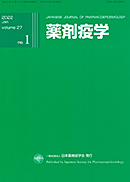Volume 27, Issue 1
Displaying 1-6 of 6 articles from this issue
- |<
- <
- 1
- >
- >|
Special Issue on “Emerging Use of Real World Data in Japan”
-
Article type: other
2022 Volume 27 Issue 1 Pages 1
Published: June 25, 2022
Released on J-STAGE: July 25, 2022
Download PDF (174K) -
Article type: editorial
2022 Volume 27 Issue 1 Pages 3-10
Published: June 25, 2022
Released on J-STAGE: July 25, 2022
Download PDF (1122K) -
Article type: editorial
2022 Volume 27 Issue 1 Pages 11-18
Published: June 25, 2022
Released on J-STAGE: July 25, 2022
Download PDF (379K) -
Article type: editorial
2022 Volume 27 Issue 1 Pages 19-24
Published: June 25, 2022
Released on J-STAGE: July 25, 2022
Download PDF (406K) -
Article type: editorial
2022 Volume 27 Issue 1 Pages 25-33
Published: June 25, 2022
Released on J-STAGE: July 25, 2022
Download PDF (724K) -
Article type: editorial
2022 Volume 27 Issue 1 Pages 34-48
Published: June 25, 2022
Released on J-STAGE: July 25, 2022
Download PDF (2335K)
- |<
- <
- 1
- >
- >|
